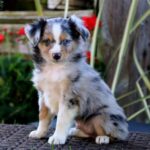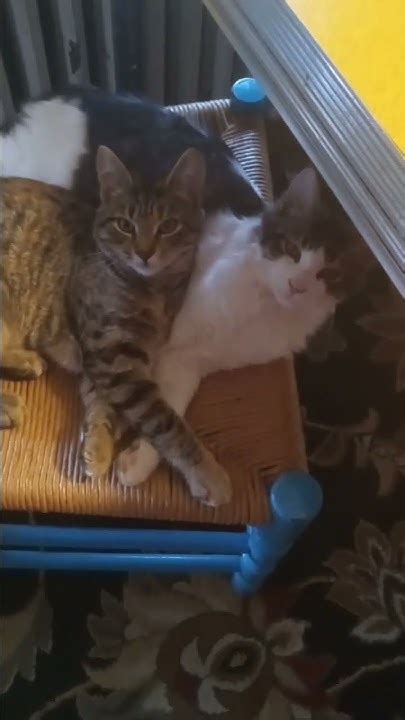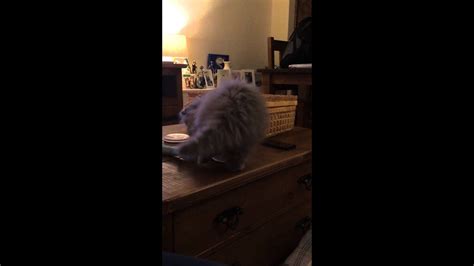
A Maine Coon kitten with a distinctive marking resembling a perfect flame on its face has captivated audiences online, sparking viral attention and admiration for its unique appearance.
A two-month-old Maine Coon kitten named Flame is setting social media ablaze with its striking facial markings. The kitten, residing in Russia, boasts a unique, naturally occurring pattern that resembles a “perfect flame,” according to its owner, leaving viewers mesmerized by its distinctive and adorable look. The kitten’s images have rapidly spread across various online platforms, garnering widespread appreciation and turning Flame into an internet sensation.
The kitten lives with its owner in Russia, where it is adored and cared for, the unique marking is not the result of any artificial coloring or design, but rather a natural phenomenon of its coat. The Flame is garnering thousands of likes and comments from people across the globe who are fascinated by its one-of-a-kind appearance.
The kitten is a testament to the beauty and diversity found within the animal kingdom, proving that nature can indeed be an extraordinary artist.
The kitten’s owner remains anonymous, focusing instead on sharing the kitten’s journey and unique features with the world. The attention and affection Flame receives serve as a reminder of the joy and wonder that animals can bring to our lives.
Beyond the Flame: Understanding Maine Coons and Their Markings
The fascination surrounding Flame’s distinctive marking naturally leads to questions about Maine Coons in general, their coat patterns, and the genetics that determine these features. Understanding these aspects provides a deeper appreciation for Flame’s unique charm and the breed as a whole.
Maine Coon Characteristics:
Maine Coons are one of the largest domesticated cat breeds, known for their intelligence, gentle nature, and distinctive physical traits. Originating from Maine, USA, they are often referred to as “gentle giants” due to their size and amiable temperament. Male Maine Coons can weigh between 13 to 18 pounds, while females typically weigh between 8 to 12 pounds. They have a long, shaggy coat that provides insulation against harsh winters, large paws with tufts of fur between the toes (acting as natural snowshoes), and a bushy tail that they use for balance and warmth.
Beyond their physical attributes, Maine Coons are known for their playful and affectionate personalities. They are often described as dog-like due to their tendency to follow their owners around the house and their ability to be trained. They are also known for their unique vocalizations, often described as a mix between a meow and a trill.
Coat Patterns and Genetics:
The coat patterns in Maine Coons, like in other cat breeds, are determined by a complex interplay of genes. The primary genes responsible for coat color are those that control the production of melanin, the pigment that gives fur its color. There are two types of melanin: eumelanin, which produces black and brown pigments, and phaeomelanin, which produces red and yellow pigments. The specific combination of these pigments determines the base coat color of a cat.
Beyond the base color, other genes control the distribution of pigment, resulting in a variety of patterns. The tabby pattern, for example, is one of the most common coat patterns in cats. There are several variations of the tabby pattern, including:
- Classic Tabby: Characterized by swirling patterns on the sides of the body.
- Mackerel Tabby: Features narrow, vertical stripes running along the sides of the body.
- Spotted Tabby: Has spots of varying sizes distributed across the body.
- Ticked Tabby: Also known as Abyssinian tabby, features hairs that are banded with different colors, giving the coat a speckled appearance.
White spotting, which is responsible for patterns like tuxedo and bicolored coats, is controlled by a separate set of genes. The amount and distribution of white spotting can vary widely, resulting in cats with just a few white markings to those that are almost entirely white.
The specific genetics behind Flame’s “perfect flame” marking are likely a unique combination of these genes, resulting in an unusual distribution of pigment that creates the flame-like pattern. While it’s impossible to pinpoint the exact genetic mechanism without genetic testing, it’s likely a combination of tabby genes and white spotting genes that have interacted in a way that produced this striking effect.
The Allure of Unique Markings:
The viral sensation of Flame highlights the human fascination with unique and unusual animal markings. Just as people are drawn to rare gemstones or unusual works of art, they are also captivated by animals that exhibit unique and striking patterns. These markings can be seen as a form of natural art, demonstrating the endless creativity of evolution.
In the case of Flame, the “perfect flame” marking is particularly appealing because of its symbolic resonance. Fire is often associated with passion, energy, and transformation, qualities that many people find appealing and inspiring. The fact that this marking appears naturally on a kitten’s face adds to its mystique and charm.
The Role of Social Media:
Social media platforms play a significant role in amplifying the appeal of animals with unique markings. Platforms like Instagram, Facebook, and TikTok allow people to share images and videos of these animals with a global audience, creating viral sensations and turning them into internet celebrities.
The widespread sharing of Flame’s photos has not only brought joy to countless people but has also helped to raise awareness about Maine Coons and the beauty and diversity found within the animal kingdom. It serves as a reminder that even in the everyday world, there is always something extraordinary to be discovered.
Responsible Pet Ownership and Ethical Considerations:
While the popularity of animals with unique markings can be exciting, it’s important to remember the ethical considerations of pet ownership. Owning a pet is a significant responsibility that requires commitment, care, and financial resources. It’s crucial to ensure that you are prepared to provide a loving and supportive home for an animal before bringing it into your life.
Additionally, it’s important to be aware of the potential for irresponsible breeding practices that can arise from the demand for animals with specific traits. Breeders should prioritize the health and well-being of their animals above all else, and should avoid breeding practices that could lead to genetic problems or health issues.
Conclusion:
Flame, the Maine Coon kitten with the “perfect flame” on its face, is a testament to the beauty and wonder that can be found in the natural world. Its unique marking has captured the hearts of people around the globe, reminding us of the joy and inspiration that animals can bring to our lives. As we celebrate the allure of Flame, it’s important to remember the ethical responsibilities of pet ownership and to prioritize the well-being of all animals.
FAQ: Maine Coon Kitten with ‘Perfect Flame’ Face
1. What makes this Maine Coon kitten so special?
The Maine Coon kitten, named Flame, has a unique, naturally occurring marking on its face that resembles a perfect flame. This distinctive pattern has captured the attention of people worldwide, making it an internet sensation due to its rarity and aesthetic appeal. According to the original article on Yahoo! Lifestyle, it’s the kitten’s “perfect flame” face that is setting “hearts ablaze.”
2. Is the flame marking on the kitten’s face natural?
Yes, the “perfect flame” marking is a natural phenomenon of the kitten’s coat. It is not the result of any artificial coloring or design. It is likely a unique combination of genes that control coat color and pattern distribution, creating the distinctive flame-like effect.
3. Where does the kitten live?
The Maine Coon kitten, Flame, resides in Russia with its owner. The owner has chosen to remain anonymous, focusing instead on sharing the kitten’s unique features and journey with the world.
4. What is a Maine Coon, and what are its characteristics?
Maine Coons are one of the largest domesticated cat breeds, originating from Maine, USA. They are known for their intelligence, gentle nature, and distinctive physical traits, including a long, shaggy coat, large paws with tufts of fur, and a bushy tail. Male Maine Coons typically weigh between 13 to 18 pounds, while females weigh between 8 to 12 pounds. They are also known for their playful and affectionate personalities.
5. How has social media contributed to the kitten’s popularity?
Social media platforms have played a significant role in amplifying the appeal of the kitten. Images and videos of Flame have been widely shared on platforms like Instagram, Facebook, and TikTok, allowing it to reach a global audience and become an internet celebrity. This has not only brought joy to many but has also raised awareness about Maine Coons and the beauty and diversity within the animal kingdom.
Expanding the Article: The Science of Cat Coat Color Genetics
To further enhance the understanding of Flame’s unique appearance, it is essential to delve deeper into the science of cat coat color genetics. This will provide a more detailed explanation of the factors that contribute to the diverse range of colors and patterns observed in cats, including the specific genes that may be responsible for Flame’s distinctive marking.
Basic Principles of Cat Coat Color Genetics:
The color and pattern of a cat’s coat are determined by a complex interaction of multiple genes. These genes control the production, distribution, and modification of pigments within the hair shafts. The two primary pigments responsible for coat color are eumelanin (black/brown) and phaeomelanin (red/yellow).
-
Eumelanin: This pigment produces black and brown colors. Variations in the gene responsible for eumelanin production can result in different shades of black, brown, and chocolate. In some cats, a dilution gene can further modify eumelanin, resulting in blue (diluted black) or lilac (diluted chocolate) colors.
-
Phaeomelanin: This pigment produces red and yellow colors. The intensity of phaeomelanin can vary, resulting in shades ranging from deep red to cream. The expression of phaeomelanin is also influenced by other genes, including the sex-linked orange gene.
The Orange Gene:
The orange gene is located on the X chromosome, meaning that its expression is linked to the sex of the cat. Females have two X chromosomes (XX), while males have one X and one Y chromosome (XY). The orange gene has two alleles: O (orange) and o (non-orange).
-
Females (XX): Females can be either orange (OO), non-orange (oo), or calico/tortoiseshell (Oo). In calico/tortoiseshell cats, the orange and non-orange alleles are expressed in different patches of fur, resulting in a mosaic pattern. This occurs due to a process called X-inactivation, where one of the X chromosomes in each cell is randomly inactivated.
-
Males (XY): Males can be either orange (OY) or non-orange (oY). Because they only have one X chromosome, they cannot be calico/tortoiseshell unless they have an unusual chromosomal abnormality (XXY).
Agouti Gene and Tabby Patterns:
The agouti gene controls the distribution of pigment within individual hairs. The agouti allele (A) allows for the banding of hairs, resulting in a tabby pattern. The non-agouti allele (a) prevents banding, resulting in a solid color.
There are four main variations of the tabby pattern:
-
Classic Tabby: Characterized by swirling patterns on the sides of the body. This pattern is caused by a recessive allele (tb) at the tabby locus.
-
Mackerel Tabby: Features narrow, vertical stripes running along the sides of the body. This is the ancestral tabby pattern and is caused by a dominant allele (Ta) at the tabby locus.
-
Spotted Tabby: Has spots of varying sizes distributed across the body. This pattern is thought to be caused by a modifier gene that breaks up the mackerel tabby stripes into spots.
-
Ticked Tabby: Also known as Abyssinian tabby, features hairs that are banded with different colors, giving the coat a speckled appearance. This pattern is caused by a dominant allele (T) at the tabby locus.
White Spotting Gene:
The white spotting gene (S) controls the presence and distribution of white fur. The dominant allele (S) results in white spotting, while the recessive allele (s) results in a solid color. The amount and distribution of white spotting can vary widely, ranging from a few white spots to almost entirely white fur.
Possible Genetic Explanation for Flame’s Marking:
Based on the information available, it is possible to speculate on the genetic factors that may have contributed to Flame’s unique “perfect flame” marking. It is likely that a combination of the agouti gene, the white spotting gene, and modifier genes are responsible for the pattern.
-
Agouti Gene: The agouti gene may be responsible for the underlying tabby pattern that is present in Flame’s coat. The specific variation of the tabby pattern is difficult to determine without closer examination, but it is possible that it is a modified mackerel or spotted tabby pattern.
-
White Spotting Gene: The white spotting gene is likely responsible for the white fur that surrounds the “perfect flame” marking. The distribution of white spotting may be influenced by modifier genes that control the size and shape of the white areas.
-
Modifier Genes: Modifier genes are genes that modify the expression of other genes. In Flame’s case, modifier genes may be responsible for the unique shape and location of the “perfect flame” marking. These genes may influence the migration of pigment-producing cells during embryonic development, resulting in the distinctive pattern.
The Role of Chance:
While genetics plays a significant role in determining coat color and pattern, chance also plays a part. Random variations in gene expression and cell migration can result in unique and unexpected patterns. It is possible that Flame’s “perfect flame” marking is the result of a rare combination of genetic factors and random developmental events.
Further Research:
To definitively determine the genetic basis of Flame’s unique marking, genetic testing would be required. This would involve analyzing Flame’s DNA to identify the specific alleles that are present at the relevant genes. This information could then be compared to the DNA of other cats with similar markings to identify common genetic factors.
Expanding the Article: The Cultural Significance of Cats
Cats have held a unique position in human culture for thousands of years, often revered as symbols of independence, mystery, and good fortune. Understanding the cultural significance of cats can provide further context for the widespread fascination with Flame and its unique appearance.
Ancient Egypt:
In ancient Egypt, cats were highly revered and considered sacred animals. They were associated with the goddess Bastet, who was depicted as a woman with the head of a cat. Bastet was the goddess of the home, fertility, and protection, and cats were believed to embody these qualities.
Cats were often mummified and buried alongside their owners, and killing a cat was considered a serious crime punishable by death. The Egyptians also used cats to control rodents and protect their crops.
Ancient Rome:
In ancient Rome, cats were initially valued for their ability to control rodents. However, over time, they also became popular as pets and were often depicted in Roman art and literature.
The Romans associated cats with the goddess Diana, who was the goddess of the hunt, the moon, and wild animals. Cats were seen as symbols of independence and freedom, and they were often kept as companions by wealthy Romans.
Middle Ages:
During the Middle Ages in Europe, the perception of cats shifted dramatically. They became associated with witchcraft and were often persecuted and killed, particularly black cats. This association stemmed from the belief that witches could transform themselves into cats and that cats were agents of evil.
The persecution of cats during the Middle Ages may have contributed to the spread of the Black Death, as the decline in the cat population allowed rodent populations to flourish, leading to increased transmission of the disease.
Renaissance:
During the Renaissance, the perception of cats began to improve. They were once again valued for their ability to control rodents and were also appreciated for their beauty and grace.
Artists such as Leonardo da Vinci and Albrecht Dürer depicted cats in their paintings and drawings, and cats became increasingly popular as pets among the wealthy and aristocratic classes.
Modern Era:
In the modern era, cats have become one of the most popular pets in the world. They are valued for their companionship, their independence, and their ability to provide comfort and stress relief.
Cats are also widely represented in popular culture, appearing in books, movies, television shows, and online media. Internet cats, such as Grumpy Cat and Lil Bub, have become global celebrities, demonstrating the enduring fascination with cats in the digital age.
The Enduring Appeal of Cats:
The enduring appeal of cats can be attributed to a number of factors, including their independence, their mystery, their beauty, and their ability to provide companionship and emotional support.
Cats are also relatively low-maintenance pets, making them well-suited for people with busy lifestyles. They are clean, quiet, and independent, and they do not require as much attention as dogs.
The Cultural Significance of Unique Markings:
The cultural significance of unique markings on animals is also worth considering. Throughout history, animals with unusual or striking markings have often been seen as special or auspicious. They may be considered symbols of good luck, prosperity, or spiritual significance.
In some cultures, animals with unique markings are believed to possess special powers or to be messengers from the gods. They may be treated with reverence and respect and may be used in religious ceremonies or rituals.
Conclusion:
The cultural significance of cats is a rich and complex topic that spans thousands of years and numerous cultures. From their revered status in ancient Egypt to their persecution during the Middle Ages and their resurgence as popular pets in the modern era, cats have played a significant role in human history and culture. The enduring fascination with cats, as evidenced by the viral sensation of Flame, highlights the unique and enduring appeal of these enigmatic creatures.
Adding More Depth: Responsible Breeding Practices and Ethical Considerations
The popularity of Flame underscores the importance of responsible breeding practices and ethical considerations within the pet industry. As demand for uniquely marked animals increases, it is crucial to ensure that breeders prioritize the health, well-being, and genetic diversity of their animals above all else.
Defining Responsible Breeding:
Responsible breeding involves a commitment to producing healthy, well-adjusted animals that are free from genetic defects and health problems. Responsible breeders prioritize the following:
-
Health Screening: Responsible breeders conduct thorough health screenings on their breeding animals to identify any genetic conditions or health problems that could be passed on to their offspring. This may include testing for conditions such as hypertrophic cardiomyopathy (HCM), polycystic kidney disease (PKD), and hip dysplasia.
-
Genetic Diversity: Responsible breeders strive to maintain genetic diversity within their breeding populations. This helps to reduce the risk of genetic defects and health problems that can arise from inbreeding.
-
Temperament: Responsible breeders select breeding animals with good temperaments. This helps to ensure that their offspring are well-adjusted and make good pets.
-
Proper Care: Responsible breeders provide their animals with proper care, including a healthy diet, regular veterinary checkups, and a stimulating environment.
-
Ethical Sales Practices: Responsible breeders sell their animals to responsible owners who are prepared to provide them with a loving and supportive home. They also provide ongoing support and guidance to their buyers.
Unethical Breeding Practices:
Unethical breeding practices prioritize profit over the health and well-being of the animals. Unethical breeders may engage in the following practices:
-
Inbreeding: Inbreeding involves breeding closely related animals together. This can increase the risk of genetic defects and health problems.
-
Breeding Animals with Health Problems: Unethical breeders may breed animals with known health problems, passing these problems on to their offspring.
-
Neglecting Animal Welfare: Unethical breeders may neglect the welfare of their animals, failing to provide them with proper care, food, and veterinary attention.
-
Selling Animals to Pet Stores: Unethical breeders often sell their animals to pet stores, where they may be subjected to poor living conditions and impulse purchases.
-
Failing to Provide Support: Unethical breeders may fail to provide ongoing support and guidance to their buyers.
Ethical Considerations for Breeders:
Breeders have a moral obligation to prioritize the health and well-being of their animals. This includes making informed decisions about breeding practices, providing proper care and socialization, and ensuring that their animals are placed in loving homes.
Breeders should also be transparent with potential buyers about the health and genetic background of their animals. They should be willing to answer questions and provide documentation to support their claims.
The Role of Consumers:
Consumers also have a role to play in promoting responsible breeding practices. By choosing to purchase animals from responsible breeders, consumers can help to support ethical breeding practices and reduce the demand for animals from unethical breeders.
Consumers should also be wary of breeders who offer animals at unrealistically low prices or who make exaggerated claims about the health or temperament of their animals.
Legislation and Regulation:
Legislation and regulation can also play a role in promoting responsible breeding practices. Many countries and regions have laws in place to protect the welfare of animals and to regulate breeding practices.
These laws may include requirements for breeders to be licensed, to provide proper care for their animals, and to conduct health screenings.
Conclusion:
Responsible breeding practices are essential for ensuring the health and well-being of animals. By prioritizing health, genetic diversity, and ethical treatment, breeders can help to produce healthy, well-adjusted animals that make good pets. Consumers also have a role to play in promoting responsible breeding practices by choosing to purchase animals from ethical breeders. The viral attention surrounding Flame serves as a reminder of the beauty and diversity of the animal kingdom, but also underscores the importance of responsible breeding to preserve the health and well-being of these animals.









